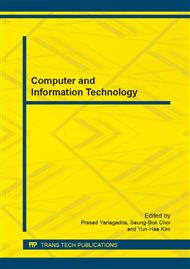[1]
H. Huang, H. Kirchne, Secure interoperation design in multi-domains environments based on colored Petri nets. International Journal of Information Sciences, Volume 221, February, 2013, pp.591-606.
DOI: 10.1016/j.ins.2012.09.027
Google Scholar
[2]
D. Basin, S. J. Burri, G. Karjoth, Dynamic enforcement of abstract separation of duty constraints. ACM Transactions on Information and System Security, Vol. 15, Issue 3, 2012, pp.30-50.
DOI: 10.1145/2382448.2382451
Google Scholar
[3]
J. Hu, R. Li, Z. Lu, J. Lu, X. Ma, RAR: A role-and-risk based flexible framework for secure collaboration. Future Generation Computer System, vol. 27, no. 5, 2011, pp.574-586.
DOI: 10.1016/j.future.2010.09.008
Google Scholar
[4]
A. Kapadia , J. Al-Muhtadi , R. Campbell , et al, IRBAC2000 : Secure interoperability using dynamic role translation. University of Illinois, Technical Report: UIUCDCS-R-2000-2162, (2000).
Google Scholar
[5]
J. Hu, R. Li,Z. Lu, On Role Mappings for RBAC-based Secure Interoperation. Proc. 3rd International Conference on Network and System Security, Gold Coast, Queensland, Australia, October, 2009, pp.270-277.
DOI: 10.1109/nss.2009.76
Google Scholar
[6]
M. Shehab, E. Bertino, and A. Ghafoor, SERAT: Secure Role mapping Technique for Decentralized Secure Interoperability, Proc. 10th ACM Symposium on Access Control, Models and Technologies, Stockholm, Sweden, 2005, p.159–167.
DOI: 10.1145/1063979.1064007
Google Scholar
[7]
B. Shafiq., J. B. D. Joshi., and E. Bertinom, Secure Interoperation in a Multi-domain Environment Employing RBAC Policies, IEEE Transactions on Knowledge and Data Engineering, vol. 17, no. 11, 2005, pp.1557-1577.
DOI: 10.1109/tkde.2005.185
Google Scholar
[8]
X. Zhang, F. Parisi-Presicce, R. Sandhu, and J. Park, Formal model and policy specification of usage control, ACM Transactions on Information and Systems Security, Vol. 8, No. 4, 2005, pp.351-387.
DOI: 10.1145/1108906.1108908
Google Scholar
[9]
H. Junbeom, N. D. Kun, Attribute-Based Access Control with Efficient Revocation in Data Outsourcing Systems, IEEE Transactions on Parallel and Distributed Systems, Vol. 22, Iss. 7, 2011, pp.1214-1221.
DOI: 10.1109/tpds.2010.203
Google Scholar
[10]
J. Park, X. Zhang, R.S. Sandhu, Attribute Mutability in Usage Control, Proc. 18th IFIP WG 11. 3 Working Conference on Data and Applications Security, Sitges, Spain, 2004, pp.15-29.
DOI: 10.1007/1-4020-8128-6_2
Google Scholar


